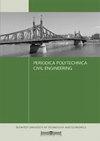Experimental and Numerical Behavior of Basalt Fiber Reinforced Short Concrete Columns Under Axial Loading
IF 1.4
4区 工程技术
Q3 ENGINEERING, CIVIL
引用次数: 0
Abstract
This paper presents experimental and numerical investigations to reveal effecting of incorporating basalt fibers into a concrete matrix on the structural behavior and loading capacity of axially loaded short columns. Six volume fractions of chopped basalt fibers are added to the same concrete mixture to prepare six identically reinforced columns. The results illustrate that the bonding forces between microfilaments and matrix increase to provide good internal confinement for concrete ingredients, which enhances compressive strength and column loading capacity. The 0.3 % basalt fiber awarded the best compressive strength, while 0.15 % and 0.3 % awarded the best load capacity to the column. The Addition of basalt fibers delays cracking to increase the cracking load by about 50 % more than no fiber column, which indicates that it needs more energy to overcome the bonding strength between filaments and matrix. At the ultimate state, the loading capacity increases by 15 % and 17 % for 0.15 % and 0.3 % of basalt fibers and by 10 % and 12 % for 0.45% and 0.6% of basalt fiber. The 0.75 % decreased compressive strength by about 6 % but raised the column's ultimate load by 18 %. Therefore, basalt fiber benefits the cracking load more than the maximum load. The finite element showed approaching the peak load in numerical and experimental results. The longitudinal rebars and ties do not yield at the ultimate state. Increasing the reinforcement ratio raises loading capacity while lowering the yield stress of bars minimizes the maximum load.玄武岩纤维增强混凝土短柱轴向荷载作用下的试验与数值分析
本文通过试验和数值研究揭示了玄武岩纤维掺入混凝土基体对轴向受压短柱结构性能和承载能力的影响。在相同的混凝土混合料中加入6种体积分数的短切玄武岩纤维,制备6根相同的配筋柱。结果表明,微丝与基体之间的结合力增加,为混凝土成分提供了良好的内部约束,从而提高了抗压强度和柱承载能力。0.3%的玄武岩纤维抗压强度最佳,0.15%和0.3%的玄武岩纤维抗压能力最佳。玄武岩纤维的加入延迟了开裂,使开裂载荷比不添加玄武岩纤维柱时增加了约50%,这表明玄武岩纤维柱需要更多的能量来克服长丝与基体之间的结合强度。在极限状态下,掺量为0.15%和0.3%的玄武岩纤维的承载力分别提高15%和17%,掺量为0.45%和0.6%的玄武岩纤维的承载力分别提高10%和12%。0.75%的掺量使柱的抗压强度降低约6%,但使柱的极限荷载提高18%。因此,玄武岩纤维对开裂荷载比最大荷载更有利。数值和实验结果均表明有限元接近峰值荷载。纵向钢筋和拉杆在极限状态下不屈服。提高配筋率可提高承载力,降低钢筋屈服应力可减小最大荷载。
本文章由计算机程序翻译,如有差异,请以英文原文为准。
求助全文
约1分钟内获得全文
求助全文
来源期刊

Periodica Polytechnica-Civil Engineering
工程技术-工程:土木
CiteScore
3.40
自引率
16.70%
发文量
89
审稿时长
12 months
期刊介绍:
Periodica Polytechnica Civil Engineering is a peer reviewed scientific journal published by the Faculty of Civil Engineering of the Budapest University of Technology and Economics. It was founded in 1957. Publication frequency: quarterly.
Periodica Polytechnica Civil Engineering publishes both research and application oriented papers, in the area of civil engineering.
The main scope of the journal is to publish original research articles in the wide field of civil engineering, including geodesy and surveying, construction materials and engineering geology, photogrammetry and geoinformatics, geotechnics, structural engineering, architectural engineering, structural mechanics, highway and railway engineering, hydraulic and water resources engineering, sanitary and environmental engineering, engineering optimisation and history of civil engineering. The journal is abstracted by several international databases, see the main page.
 求助内容:
求助内容: 应助结果提醒方式:
应助结果提醒方式:


